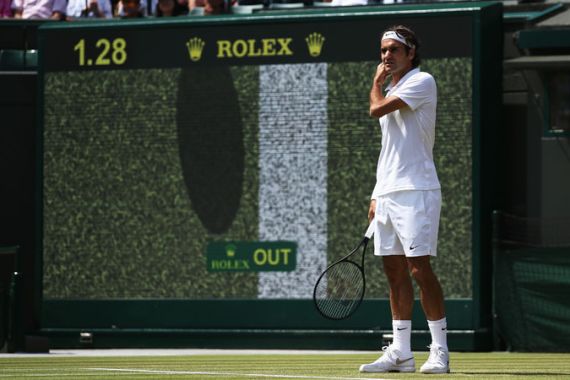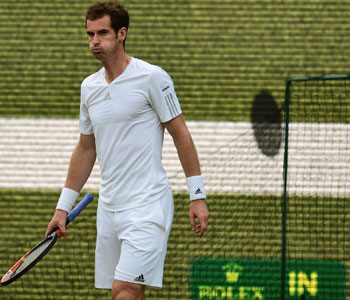Courting the Technological Edge
Hawk-Eye, an Aggressive Index, ‘Intelligent’ rackets – technology plays a crucial role in preparing players for matches.

Tennis can often look like a simple battle. Two people stand on opposing sides armed with rackets, the winner decided by who has the physical strength, technique and mental calm to claim victory.
But if you scratch beneath the surface, there are a myriad of factors that come into play. And while there may be no substitution for talent or training, another T is playing an increasingly important part in giving players the crucial advantage – Technology.
Keep reading
list of 4 itemsWTA Finals to be held in Saudi Arabia from 2024-2026
Djokovic, Ivanisevic split after 12 Grand Slam victories
‘Tragedy’: Tennis star Sabalenka heartbroken over ex-boyfriend’s death
Behind the scenes technological innovations are helping to drive athletes towards their limits and push opponents to theirs.
When people think of technology and tennis their mind might fly to Hawk-Eye, which revolutionised the game when it was formally introduced in 2005.
Unlike in cricket and football, where there have been hiccups and delays, Hawk-Eye proved a natural fit and added an extra dimension, and some synchronised clapping, to the game.
With a limited number of challenges allowed during a match, a wrong decision can prove costly in tight matches.
But while the Hawk-Eye adjudication system can effect a few points, it is the Hawk-Eye camera’s ability to track balls which is creating a wealth of knowledge for the world’s top racket wielders.
Hidden away in a bunker in Wimbledon the IBM team are busy recording every point, serve, return, move made at the Grand Slams.
While county tennis players are hired by IBM to record information manually court-side, Hawk-Eye’s player tracking devices provide additional information.
Analysing opponents
The data gathered is so rich it enables computers to search for patterns and extract a number of ‘keys’, which determine what a player has to do against their opponent to win a match.
In 2014, a new system has been tracking the aggressiveness of a player and how they play and respond to aggressive shots.
“The extra knowledge we get now is really important,” Dutch player Maikel Scheffers, a finalist in the wheelchair gentleman’s doubles, tells Al Jazeera English.
Players are getting carbon fibre seats that are moulded to your body using 3D technology.
“We have a special video team who record matches for us and then give us a copy. They put a lot of work in and it’s amazing. You can ask them to find the exact point you want to look at, so all the deuces we had in a game.
“I particularly find recording myself in training helpful. As I can watch it every day and when I have a match it is fresh in my mind. I can visualise that technique.”
While knowledge is key, and in IBM speak, ‘keys’ are knowledge, equipment is also undergoing a technology revolution. This is particularly important in wheelchair tennis.
“There are many changes being made and more to come. Players are getting carbon fibre seats that are moulded to your body using 3D technology,” says Ronald Vink, Scheffers’ doubles partner.
“The chairs are getting lighter and stronger. Some people have chairs made of magnesium. People are looking into sitting at different angles or with your knees higher up.”
With so much innovation, the ITF federation who govern wheelchair tennis have the tricky task of ensuring technological improvements for people with disabilities do not create an uneven playing field.
“There are lots of meetings at the moment, about things like the height of the chair. It is easier to serve higher up but then not everyone can do it,” says Scheffers.
“It is the same in every sport,” adds Vink. “The swimsuits in swimming, long-putters in golf. In wheelchair basketball there are lots of rules now.”
“The world championships are taking place in South Korea and there is a team with lasers monitoring every chair to make sure it isn’t a mm too high. It is getting crazy like that.”
Racket IQ
In the 1960s and 1970s, changes to the material and design of tennis rackets saw companies produce rackets with more power and control. Now French equipment company Babolat has decided to give them a brain.
This racket contains sensors inside the handle that detect various information about your game; number of strokes, where the ball is hitting the racket, endurance levels, spin and power. This information is all directly transferred into an app on an iPhone.
At Wimbledon there are already a number of players using the racket including Ana Konjuh, the young Croatian who won her first ever grand slam match this year at Wimbledon.
 |
| Technology has added more excitement to tennis [AFP] |
While these players have a more refined source of data readily available to them after matches and training, it is too early to tell what difference this technology can make.
“For coaches this racket is very important – we don’t need to stand there ticking boxes,” said Tony Nadal, Rafael’s coach and uncle.
“If Rafael had this racket 10 years ago, I am sure he would have less problems in his tennis. At the US Open we plan to use this racket and hopefully we can win the tournament with this racket.”
Whether this is marketing talk or truth is unclear but the use of sensors to give players more information about their game is a step forward.
“I think the new Babolat racket technology is fantastic, it detects everything, spin-slice, power. It is also good for amateurs because they can track their progress and compare results with other amateurs and professionals,” Japanese tennis player Yuichi said.
If the current technology is impressive, the future could be closer to science fiction.
‘Connected’ rackets provide useful information but they cannot detect whether the ball went in or out. However, if Wimbledon’s partners Babolat and Hawk-Eye join forces we could soon see an even smarter racket on the market, one that combines stats with the visuals that players find so helpful.
With sport increasingly lucrative, the Federer and Nadals of the technological world are competing in their own battle – to produce the technology that no player can live without.
The purists will argue that only the naturally gifted will triumph – but few players would want to be left out of the technological loop.